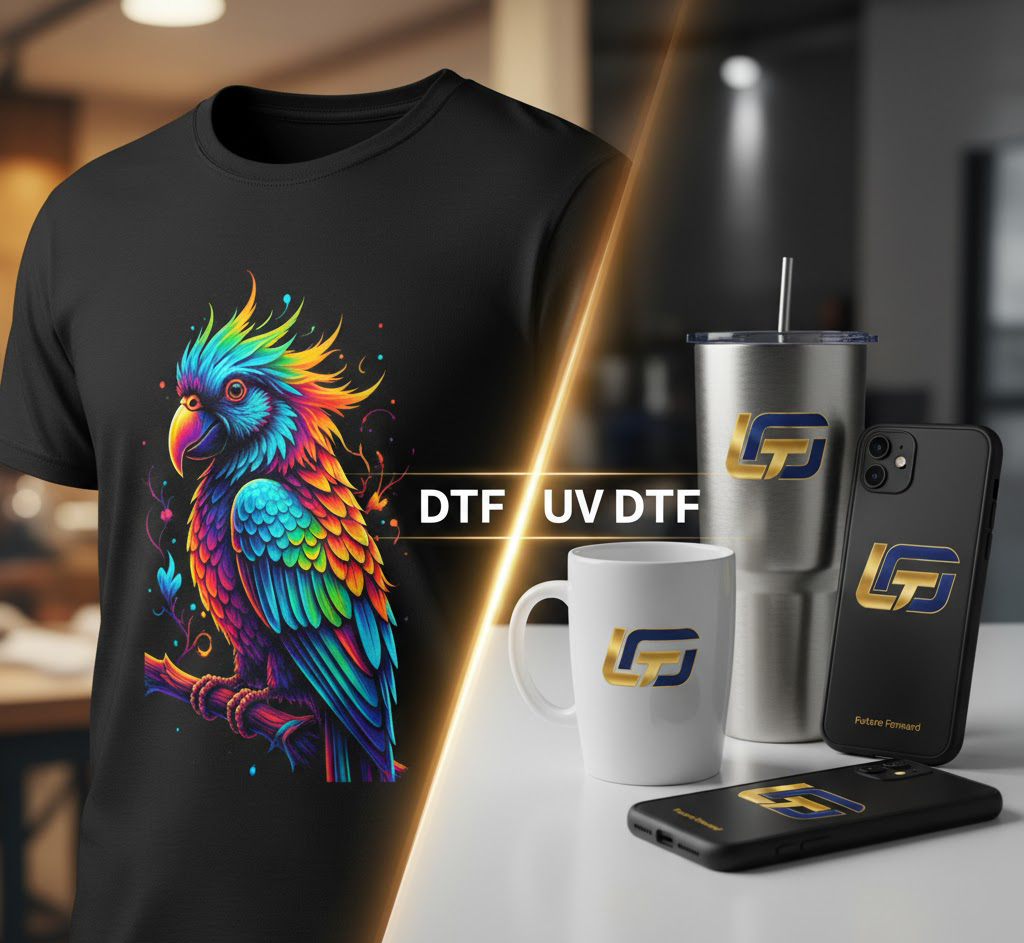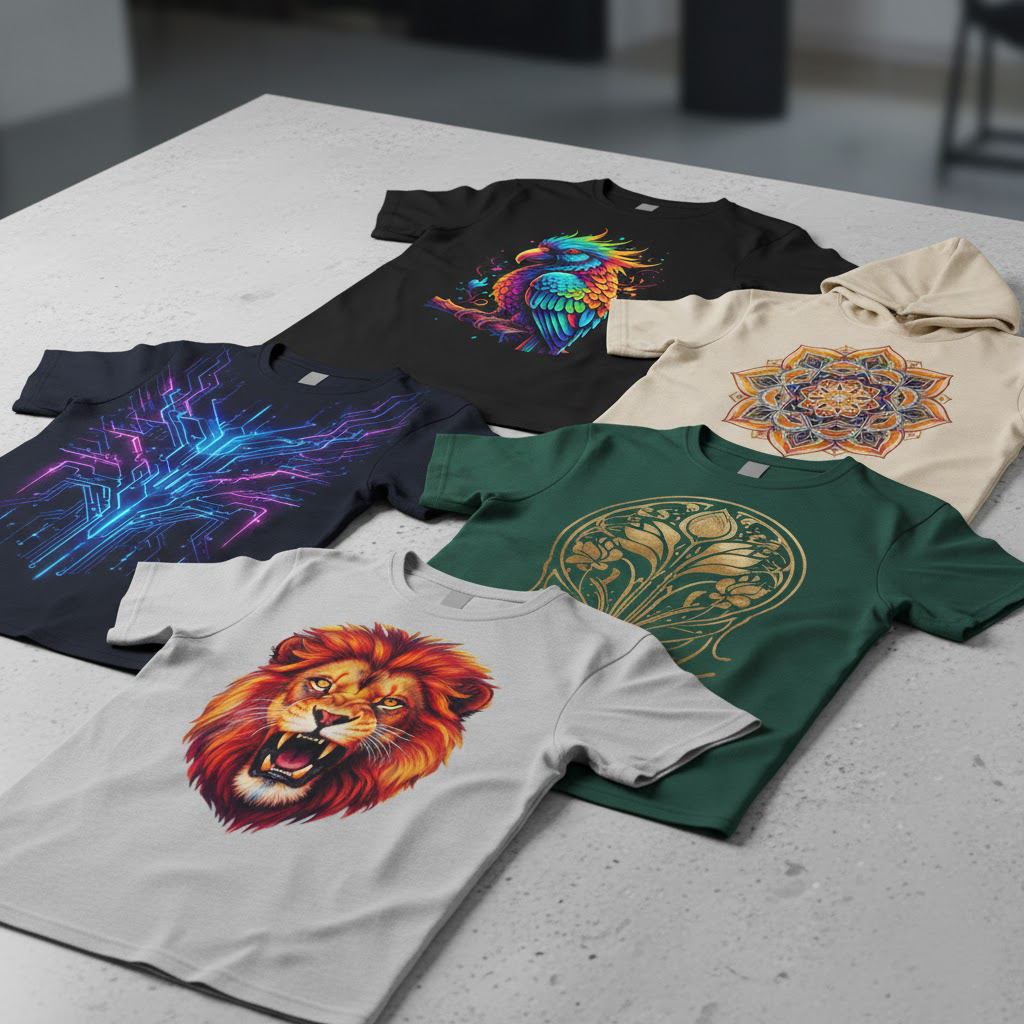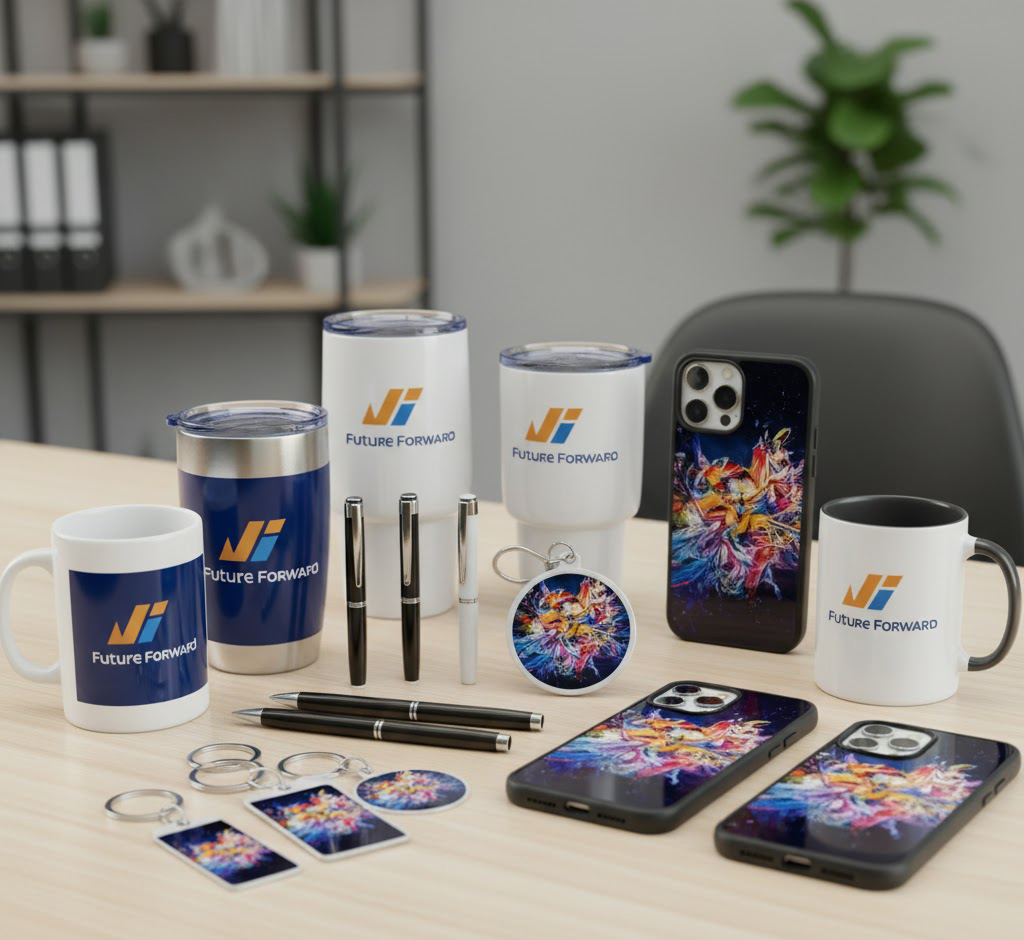English 

T: +86-180-0799-3137
E: info@refinecolor.com
E: info@refinecolor.com
9F, Building 25, Tian 'an Shenchuanggu, Fenggang Town, Dongguan 523703, China

Views: 0 Author: Refinecolor-Eason Publish Time: 2025-10-15 Origin: Site











Founded in 2008, Refinecolor Technology specializes in environmentally friendly digital printers, offering solutions for studios, small businesses, and industrial clients alike Contact us: [info@refinecolor.com] |www.refinecolor.com
Direct-to-Film (DTF) and its innovative counterpart, UV Direct-to-Film (UV DTF), have emerged as transformative technologies. Each technology opens up its own world — DTF fits the textile crowd, while UV DTF reaches far beyond fabrics into hard-surface customization.If you’re planning to grow your printing business, it really helps to understand what sets these two methods apart before you invest in new gear. Let's exploring their processes, applications, and economic implications to help you decide which technology will best fuel your business's growth.

Direct-to-Film (DTF) printing is designed primarily for decorating textiles and fabrics. It involves printing a design directly onto a special PET film using water-based pigment inks, including a crucial white ink base. This printed film is then coated with a hot-melt adhesive powder, cured with heat, and finally transferred onto the garment using a heat press. The result is a full-color, high-resolution graphic with a soft feel that adheres to a vast array of fabrics.
Fabric Versatility: Works flawlessly on cotton, polyester, blends, leather, nylon, and more, regardless of color.
White Ink System: Models like the A3+ L1800 and RF-CF30 feature sophisticated white ink circulation and stirring systems to prevent nozzle clogs and ensure opaque, vibrant prints on dark materials.
Multi-Step Process: The workflow involves printing, powdering, melting, and heat pressing.
Heat-Based Adhesion: Relies on a heat press to melt the adhesive powder and bond the print to the fabric fibers.
✅ Exceptional detail and vibrant, full-color graphics.
✅ Excellent stretchability and durability with good wash resistance.
✅ You can skip the messy pre-treatment step that DTG printing still needs — a huge time saver for small shops.
✅ Cost-effective for small to medium-sized production runs.
❌ The process is multi-stepped and can be more time-consuming than other methods.
❌ Primarily limited to fabrics and soft goods.
❌ Requires both a printer and a heat press for application.
UV Direct-to-Film (UV DTF) printing is for decorating hard, rigid, and irregular-shaped surfaces. This process uses UV-curable inks to print designs onto a special A/B film system. Think of the “A” film as your print base and the “B” film as the sticky layer that carries it to the final surface. The printer, such as the RF-ZZ2F, prints the design with color, white ink, and a layer of varnish directly onto the "A" film. The "B" film is then laminated to it. The finished print feels like a premium, glossy decal — just peel it off and stick it onto glass, metal, or plastic. No heat press, no fuss..
Hard Surface Specialist: Designed for glass, metal, wood, plastic, ceramic, acrylic, and more.
Instant Curing: Uses UV LED lamps to instantly cure the ink during printing, creating a finished, durable layer.
Varnish Layer: The addition of a varnish layer provides a glossy, embossed effect and adds significant scratch and water resistance.
Integrated System: Advanced models like the RF-ZZ2F combine printing and lamination into a single, streamlined roll-to-roll process.
✅ Incredible versatility for branding a wide range of promotional products and hard goods.
✅ Produces vibrant, high-gloss, and slightly raised 3D-textured prints.
✅ Extremely durable, waterproof, and scratch-resistant.
✅ Simple peel-and-stick application requires no heat press.
❌ Higher initial equipment and consumable costs compared to traditional DTF.
❌ Not suitable for flexible fabrics as the print is rigid.
❌ The transfer has a distinct sticker-like feel and thickness.
The first time you peel the film and press it onto fabric, the colors pop instantly — that soft, buttery feel is what keeps creators hooked on DTF.
The magic of UV DTF lies in its unique chemistry and multi-layered film system, which together create a powerful bond on non-porous substrates.
Unlike water-based DTF inks that dry by evaporation, UV DTF inks are composed of monomers, oligomers, pigments, and photoinitiators. When the printed film passes under the printer's built-in UV LED lamp, the photoinitiators react instantly to the ultraviolet light. This triggers a process called polymerization, where the liquid monomers and oligomers cross-link to form a solid, durable plastic layer in milliseconds. This instant "curing" is what gives UV DTF prints their immediate durability.
The process relies on a two-film system:
1. Film A (Print Base Film): A PET release liner coated with a special agent that allows the cured UV ink to adhere just enough to be printed on but releases it cleanly upon application.
2.Film B (Masking/Transfer Film): A transparent film with a strong pressure-sensitive adhesive. After printing on Film A, Film B is laminated over the top, picking up the entire cured design.
When the user peels away Film B, the complete, multi-layered print (varnish, color, white ink) lifts off Film A, with its adhesive side now exposed. The print is then firmly pressed onto the final product. The pressure-sensitive adhesive forms a powerful, permanent bond with the surface, making the transfer robust and long-lasting without any need for heat.
Feature | DTF (for Textiles) | UV DTF (for Hard Goods) |
Primary Application | Fabrics: T-shirts, hoodies, hats, bags | Hard Surfaces: Mugs, tumblers, helmets, wood, glass |
Printing Process | Print on film -> Apply powder -> Melt powder -> Press | Print on Film A -> Laminate Film B -> Peel & Stick |
Curing Process | Heat from a curing oven/dryer and a heat press | UV Light from an integrated LED lamp |
Ink & Film Type | Water-based pigment inks; PET film & hot-melt powder | UV-curable inks (CMYK+W+Varnish); A/B film system |
Drying / Curing Time | Minutes (for melting powder and pressing) | Instantaneous (cures during printing) |
Durability | Excellent washability & stretchability | Superior scratch, UV, and water resistance |
Print Quality | Soft-hand feel, matte to satin finish | Glossy, slightly raised 3D "crystal label" effect |
Production Speed | ~3-4 sq. meters/hour (e.g., RF-CF30) | Faster application workflow; ~160s/A4 print time (RF-ZZ2F) |
Equipment Cost | Generally lower initial investment | Higher initial investment |
UV DTF may ask for a higher upfront cost, but many shop owners say the payoff — both in time saved and product wow factor — comes faster than they expected
The key is knowing which one fits your workflow and profit goals — that’s what really determines your return..
Unlocks the Apparel Market: The single greatest benefit is its ability to produce high-quality custom apparel on demand, serving a massive and ever-growing market.
Superior Quality on Any Fabric: DTF overcomes the limitations of other methods, delivering vibrant, detailed prints on dark polyester, cotton, and blends with equal ease.
Operational Flexibility: You can print transfers in batches and press them onto garments as orders come in, enabling an efficient print-on-demand business model.
Expands Product Offerings: UV DTF allows you to enter the lucrative promotional products and personalization market, branding items that were previously difficult or impossible to decorate.
Unmatched Efficiency: The simple peel-and-stick application dramatically reduces labor and eliminates the need for bulky heat presses or jigs, speeding up production.
Premium, Durable Finish: The glossy, embossed effect created by the varnish layer gives products a high-end, professional look that commands a higher price point.
DTF printing reigns supreme here. It's the go-to choice for brands creating custom T-shirts with intricate designs, sportswear companies needing durable logos on polyester jerseys, and small businesses on Etsy selling personalized tote bags and hoodies.

UV DTF excels in creating durable, waterproof warning labels, branding logos on equipment, and adding premium packaging details. Its resistance to chemicals and abrasion makes it ideal for industrial environments.

Think of branding company logos on travel mugs, personalizing phone cases with unique art, decorating glass awards, or adding logos to helmets and other sporting goods.
Case Study: Small Business Success with UV DTF
PromoPros is a local print shop originally focused on T-shirt customization, run by owner Sarah. She noticed that more and more businesses were seeking personalized hard-surface promotional products. After conducting market research, she decided to invest in an RF-ZZ2F UV DTF printer to expand their services.
During the first week after purchasing the equipment, Sarah and her team spent two days familiarizing themselves with the printing workflow: from uploading designs to printing, laminating, and finishing the products. On the third day of testing, Sarah finally hit “print” on a company logo for a client’s hard hat. The UV lamp flashed across the film, and within seconds, the bright red logo cured right before their eyes — glossy, raised, and sharper than they’d ever seen.
When the team peeled off the film and saw how cleanly the print transferred, everyone paused for a second — then broke into smiles. Sarah just said quietly, “Okay, this is really going to work.”
When the first small batch of hard hats and mugs went out, the feedback was immediate. One client wrote back, “We didn’t expect a one-off order to look this premium!” That single email convinced Sarah she’d found her next growth engine.Sarah realized that this new service perfectly met the market demand for small-batch, high-quality custom products.
At first, the mugs came out a bit dull — we didn’t realize the varnish setting was off. But after a week of tweaking, the prints finally looked the way Sarah imagined The team began planning additional product lines, including travel mugs, laptop cases, and personalized trophies. The UV DTF technology allowed them to accept orders on demand without being limited by traditional batch production.
For Sarah, this was not just a business expansion—it was a strategic transformation. Every completed product felt like an exploration into a new market. The high quality and efficiency offered by UV DTF technology gave the team both confidence and a strong sense of accomplishment.
DTF: Entry-level systems, like modified A3+ L1800 printers, can be relatively affordable. Professional roll-to-roll systems like the RF-CF30 represent a moderate investment. You must also budget for a powder shaker/dryer and a quality heat press.
UV DTF: All-in-one printers like the RF-ZZ2F, which handle both printing and lamination, represent a higher initial capital expenditure due to the precision engineering, dual printheads, and integrated UV curing system.
DTF: Costs include PET film, CMYK and white inks, and adhesive powder. Per-print costs are generally lower.
UV DTF: Costs include the specialized A/B film set and the more expensive UV-curable inks and varnish. The per-print cost for consumables is typically higher than DTF.
This is where UV DTF shows a strong advantage. The time saved by eliminating the powdering, melting, and heat-pressing steps can be significant. The application is a simple peel-and-stick process that requires minimal training and time, reducing labor costs per item.
While DTF has a lower entry cost, UV DTF can offer a faster ROI for businesses targeting the high-margin promotional products market. The ability to create premium, personalized hard goods allows for higher pricing per item. Your profits will depend on where you play — mass-produced shirts or high-margin custom mugs.
The future of UV DTF printing is exceptionally promising, fueled by rapid innovations in hardware, inks, and workflow automation. Printers are getting faster and smaller every year, and new UV inks now stick to just about anything — even tricky materials like glass and coated metal—including glass, metal, wood, and plastics—without compromising durability or visual quality. At the same time, the global demand for personalized, high-quality products continues to surge, creating a wealth of opportunities for businesses to offer one-off custom items and expand into markets that were previously hard to reach. For shops that jump in early, UV DTF isn’t just efficient — it’s a real edge that can boost both your brand image and your bottom line.
The UV DTF industry is witnessing rapid technological evolution. Newer machines are designed to be more compact, faster, and energy-efficient, allowing businesses to produce high-quality prints with lower operational costs. Advances in UV LED curing technology enable instant ink polymerization with minimal heat, reducing energy consumption while maintaining superior durability. At the same time, eco-friendly UV-curable inks are becoming more widely available, offering flexible, non-toxic formulations that can adhere to a broader range of surfaces, including glass, metal, wood, and plastics. For printers, this means the ability to expand product offerings while minimizing environmental impact, which is increasingly valued by both businesses and end consumers.
Consumer demand for personalized products continues to grow at an unprecedented pace. Customers increasingly seek unique, one-off items that reflect their identity or brand, ranging from customized mugs and phone cases to corporate gifts and limited-edition merchandise. UV DTF printing is perfectly positioned to meet this demand because of its ability to deliver vibrant, durable, and high-gloss prints on hard, irregular surfaces. Market forecasts suggest that businesses offering hyper-personalized, high-quality products will capture a premium segment of the market. Early adoption of UV DTF technology allows companies to stay ahead of competitors and respond quickly to niche trends, such as eco-conscious products or seasonal promotional items.
Businesses that invest in UV DTF technology now can establish themselves as leaders in the hyper-personalization market. Offering unique decoration services on a wide range of products creates a significant competitive advantage that is difficult for traditional print shops to replicate.
The decision between DTF and UV DTF is not about which is "better," but which is right for your business model and target market.
Choose DTF if your core business is, or will be, customized apparel and textiles. If your primary goal is to print on T-shirts, hoodies, sportswear, bags, and other fabrics, DTF offers the ideal combination of quality, durability, and cost-effectiveness. It is the definitive modern solution for the garment decoration industry.
Choose UV DTF if your business focuses on promotional products, signage, and personalizing hard goods. If you want to brand everything from mugs and phone cases to metal plaques and wooden boxes, UV DTF provides unparalleled versatility and efficiency. It is the key to unlocking a vast new world of product customization beyond textiles.
Refinecolor Printer will meet you at the ISA Expo in the USA
Refinecolor Printer Attending 2025 SAUDI SIGNAGE & LABELLING EXPO
How Does The UV Printer’s Vision Positioning CCD System Work?
Refinecolor and Epson China participated in the CHN GIFT EXPO in Shanghai
UV Printing Future: The Integration of UV Printing And Laser Cutting in One Machine
UV Label Printer Vs UV DTF Printer: Choosing The Best Solution for Your Business
DTF vs UV DTF: Choosing the Right Printing Technology for Your Business Growth